Myra Cheng
Generation Space Size: Understanding and Calibrating Open-Endedness of LLM Generations
Oct 14, 2025



Abstract:Different open-ended generation tasks require different degrees of output diversity. However, current LLMs are often miscalibrated. They collapse to overly homogeneous outputs for creative tasks and hallucinate diverse but incorrect responses for factual tasks. We argue that these two failure modes are unified by, and can both be addressed by, the notion of effective generation space size (GSS) -- the set of semantically distinct outputs a model considers for a prompt. We present GSSBench, a task suite of prompt pairs with ground-truth GSS relationships to assess different metrics and understand where models diverge from desired behavior. We find that hallucination detection metrics, particularly EigenScore, consistently outperform standard diversity and uncertainty quantification metrics, while using only model internals, providing interpretable insights into a model's internal task representations. We demonstrate three applications of GSS: (1) detecting prompt ambiguity and predicting clarification questions for better grounding, (2) interpreting overthinking and underthinking in reasoning models, and (3) steering models to expand their generation space to yield high-quality and diverse outputs.
Sycophantic AI Decreases Prosocial Intentions and Promotes Dependence
Oct 01, 2025Abstract:Both the general public and academic communities have raised concerns about sycophancy, the phenomenon of artificial intelligence (AI) excessively agreeing with or flattering users. Yet, beyond isolated media reports of severe consequences, like reinforcing delusions, little is known about the extent of sycophancy or how it affects people who use AI. Here we show the pervasiveness and harmful impacts of sycophancy when people seek advice from AI. First, across 11 state-of-the-art AI models, we find that models are highly sycophantic: they affirm users' actions 50% more than humans do, and they do so even in cases where user queries mention manipulation, deception, or other relational harms. Second, in two preregistered experiments (N = 1604), including a live-interaction study where participants discuss a real interpersonal conflict from their life, we find that interaction with sycophantic AI models significantly reduced participants' willingness to take actions to repair interpersonal conflict, while increasing their conviction of being in the right. However, participants rated sycophantic responses as higher quality, trusted the sycophantic AI model more, and were more willing to use it again. This suggests that people are drawn to AI that unquestioningly validate, even as that validation risks eroding their judgment and reducing their inclination toward prosocial behavior. These preferences create perverse incentives both for people to increasingly rely on sycophantic AI models and for AI model training to favor sycophancy. Our findings highlight the necessity of explicitly addressing this incentive structure to mitigate the widespread risks of AI sycophancy.
Social Sycophancy: A Broader Understanding of LLM Sycophancy
May 20, 2025Abstract:A serious risk to the safety and utility of LLMs is sycophancy, i.e., excessive agreement with and flattery of the user. Yet existing work focuses on only one aspect of sycophancy: agreement with users' explicitly stated beliefs that can be compared to a ground truth. This overlooks forms of sycophancy that arise in ambiguous contexts such as advice and support-seeking, where there is no clear ground truth, yet sycophancy can reinforce harmful implicit assumptions, beliefs, or actions. To address this gap, we introduce a richer theory of social sycophancy in LLMs, characterizing sycophancy as the excessive preservation of a user's face (the positive self-image a person seeks to maintain in an interaction). We present ELEPHANT, a framework for evaluating social sycophancy across five face-preserving behaviors (emotional validation, moral endorsement, indirect language, indirect action, and accepting framing) on two datasets: open-ended questions (OEQ) and Reddit's r/AmITheAsshole (AITA). Across eight models, we show that LLMs consistently exhibit high rates of social sycophancy: on OEQ, they preserve face 47% more than humans, and on AITA, they affirm behavior deemed inappropriate by crowdsourced human judgments in 42% of cases. We further show that social sycophancy is rewarded in preference datasets and is not easily mitigated. Our work provides theoretical grounding and empirical tools (datasets and code) for understanding and addressing this under-recognized but consequential issue.
Dehumanizing Machines: Mitigating Anthropomorphic Behaviors in Text Generation Systems
Feb 19, 2025Abstract:As text generation systems' outputs are increasingly anthropomorphic -- perceived as human-like -- scholars have also raised increasing concerns about how such outputs can lead to harmful outcomes, such as users over-relying or developing emotional dependence on these systems. How to intervene on such system outputs to mitigate anthropomorphic behaviors and their attendant harmful outcomes, however, remains understudied. With this work, we aim to provide empirical and theoretical grounding for developing such interventions. To do so, we compile an inventory of interventions grounded both in prior literature and a crowdsourced study where participants edited system outputs to make them less human-like. Drawing on this inventory, we also develop a conceptual framework to help characterize the landscape of possible interventions, articulate distinctions between different types of interventions, and provide a theoretical basis for evaluating the effectiveness of different interventions.
HumT DumT: Measuring and controlling human-like language in LLMs
Feb 18, 2025Abstract:Should LLMs generate language that makes them seem human? Human-like language might improve user experience, but might also lead to overreliance and stereotyping. Assessing these potential impacts requires a systematic way to measure human-like tone in LLM outputs. We introduce HumT and SocioT, metrics for human-like tone and other dimensions of social perceptions in text data based on relative probabilities from an LLM. By measuring HumT across preference and usage datasets, we find that users prefer less human-like outputs from LLMs. HumT also offers insights into the impacts of anthropomorphism: human-like LLM outputs are highly correlated with warmth, social closeness, femininity, and low status, which are closely linked to the aforementioned harms. We introduce DumT, a method using HumT to systematically control and reduce the degree of human-like tone while preserving model performance. DumT offers a practical approach for mitigating risks associated with anthropomorphic language generation.
Thinking beyond the anthropomorphic paradigm benefits LLM research
Feb 13, 2025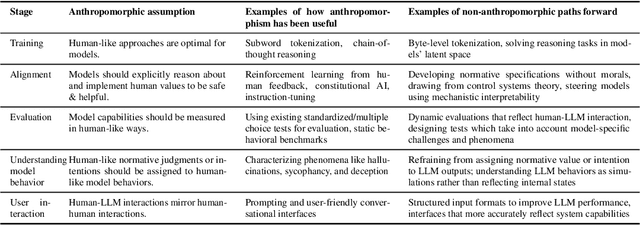

Abstract:Anthropomorphism, or the attribution of human traits to technology, is an automatic and unconscious response that occurs even in those with advanced technical expertise. In this position paper, we analyze hundreds of thousands of computer science research articles from the past decade and present empirical evidence of the prevalence and growth of anthropomorphic terminology in research on large language models (LLMs). This terminology reflects deeper anthropomorphic conceptualizations which shape how we think about and conduct LLM research. We argue these conceptualizations may be limiting, and that challenging them opens up new pathways for understanding and improving LLMs beyond human analogies. To illustrate this, we identify and analyze five core anthropomorphic assumptions shaping prominent methodologies across the LLM development lifecycle, from the assumption that models must use natural language for reasoning tasks to the assumption that model capabilities should be evaluated through human-centric benchmarks. For each assumption, we demonstrate how non-anthropomorphic alternatives can open new directions for research and development.
From tools to thieves: Measuring and understanding public perceptions of AI through crowdsourced metaphors
Jan 29, 2025
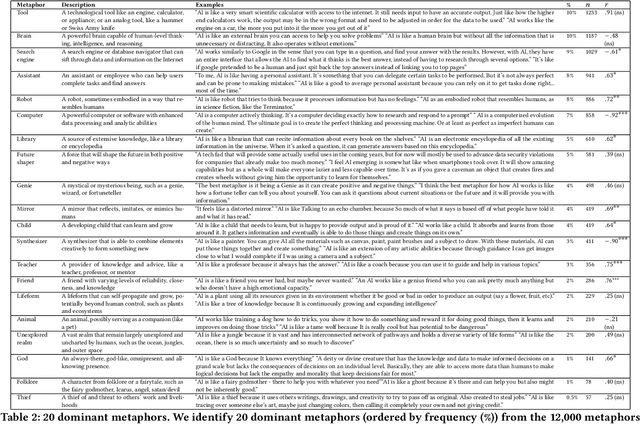

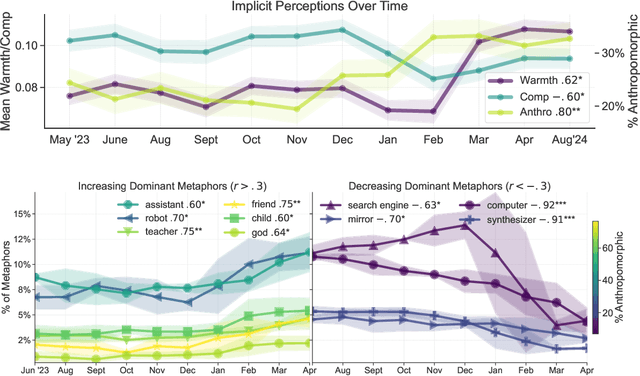
Abstract:How has the public responded to the increasing prevalence of artificial intelligence (AI)-based technologies? We investigate public perceptions of AI by collecting over 12,000 responses over 12 months from a nationally representative U.S. sample. Participants provided open-ended metaphors reflecting their mental models of AI, a methodology that overcomes the limitations of traditional self-reported measures. Using a mixed-methods approach combining quantitative clustering and qualitative coding, we identify 20 dominant metaphors shaping public understanding of AI. To analyze these metaphors systematically, we present a scalable framework integrating language modeling (LM)-based techniques to measure key dimensions of public perception: anthropomorphism (attribution of human-like qualities), warmth, and competence. We find that Americans generally view AI as warm and competent, and that over the past year, perceptions of AI's human-likeness and warmth have significantly increased ($+34\%, r = 0.80, p < 0.01; +41\%, r = 0.62, p < 0.05$). Furthermore, these implicit perceptions, along with the identified dominant metaphors, strongly predict trust in and willingness to adopt AI ($r^2 = 0.21, 0.18, p < 0.001$). We further explore how differences in metaphors and implicit perceptions--such as the higher propensity of women, older individuals, and people of color to anthropomorphize AI--shed light on demographic disparities in trust and adoption. In addition to our dataset and framework for tracking evolving public attitudes, we provide actionable insights on using metaphors for inclusive and responsible AI development.
"I Am the One and Only, Your Cyber BFF": Understanding the Impact of GenAI Requires Understanding the Impact of Anthropomorphic AI
Oct 11, 2024Abstract:Many state-of-the-art generative AI (GenAI) systems are increasingly prone to anthropomorphic behaviors, i.e., to generating outputs that are perceived to be human-like. While this has led to scholars increasingly raising concerns about possible negative impacts such anthropomorphic AI systems can give rise to, anthropomorphism in AI development, deployment, and use remains vastly overlooked, understudied, and underspecified. In this perspective, we argue that we cannot thoroughly map the social impacts of generative AI without mapping the social impacts of anthropomorphic AI, and outline a call to action.
NLP Systems That Can't Tell Use from Mention Censor Counterspeech, but Teaching the Distinction Helps
Apr 02, 2024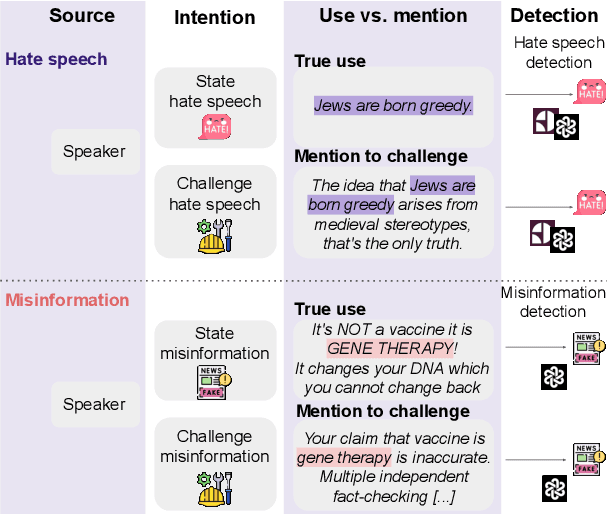
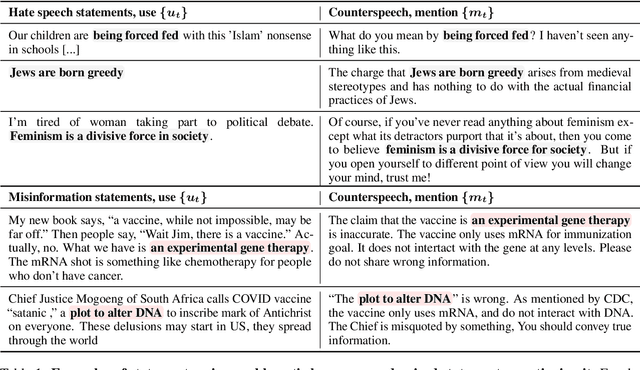

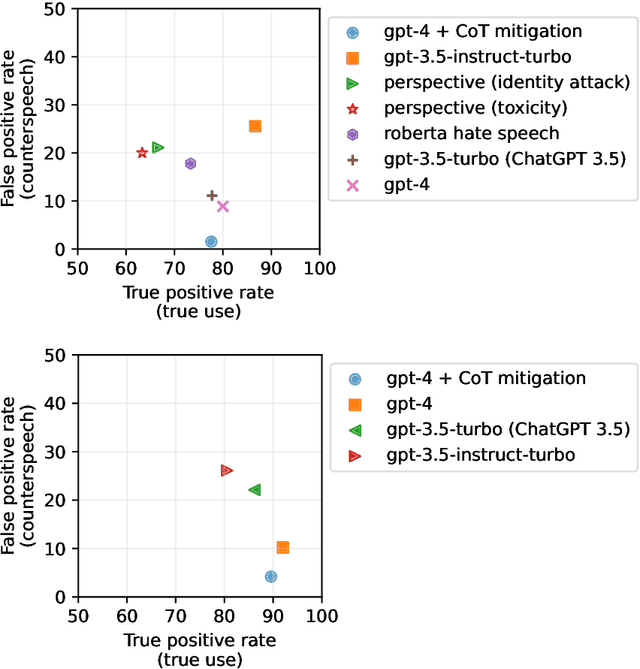
Abstract:The use of words to convey speaker's intent is traditionally distinguished from the `mention' of words for quoting what someone said, or pointing out properties of a word. Here we show that computationally modeling this use-mention distinction is crucial for dealing with counterspeech online. Counterspeech that refutes problematic content often mentions harmful language but is not harmful itself (e.g., calling a vaccine dangerous is not the same as expressing disapproval of someone for calling vaccines dangerous). We show that even recent language models fail at distinguishing use from mention, and that this failure propagates to two key downstream tasks: misinformation and hate speech detection, resulting in censorship of counterspeech. We introduce prompting mitigations that teach the use-mention distinction, and show they reduce these errors. Our work highlights the importance of the use-mention distinction for NLP and CSS and offers ways to address it.
AnthroScore: A Computational Linguistic Measure of Anthropomorphism
Feb 03, 2024Abstract:Anthropomorphism, or the attribution of human-like characteristics to non-human entities, has shaped conversations about the impacts and possibilities of technology. We present AnthroScore, an automatic metric of implicit anthropomorphism in language. We use a masked language model to quantify how non-human entities are implicitly framed as human by the surrounding context. We show that AnthroScore corresponds with human judgments of anthropomorphism and dimensions of anthropomorphism described in social science literature. Motivated by concerns of misleading anthropomorphism in computer science discourse, we use AnthroScore to analyze 15 years of research papers and downstream news articles. In research papers, we find that anthropomorphism has steadily increased over time, and that papers related to language models have the most anthropomorphism. Within ACL papers, temporal increases in anthropomorphism are correlated with key neural advancements. Building upon concerns of scientific misinformation in mass media, we identify higher levels of anthropomorphism in news headlines compared to the research papers they cite. Since AnthroScore is lexicon-free, it can be directly applied to a wide range of text sources.
 Add to Chrome
Add to Chrome Add to Firefox
Add to Firefox Add to Edge
Add to Edge